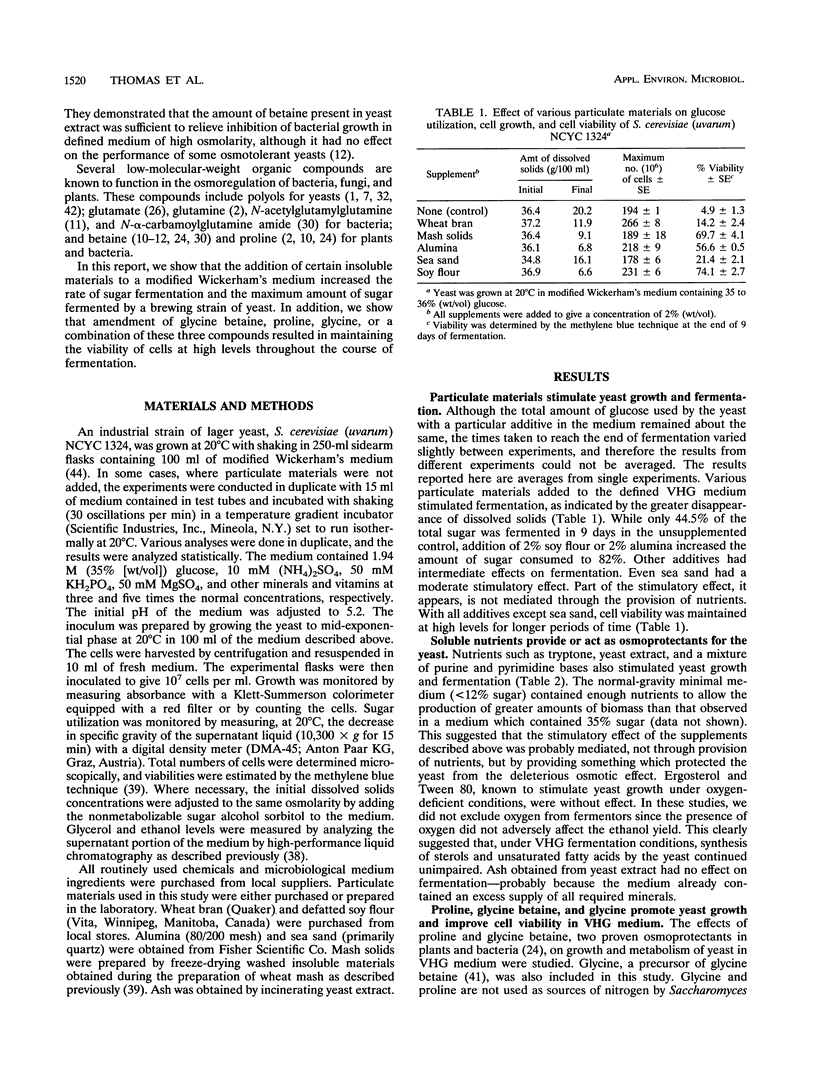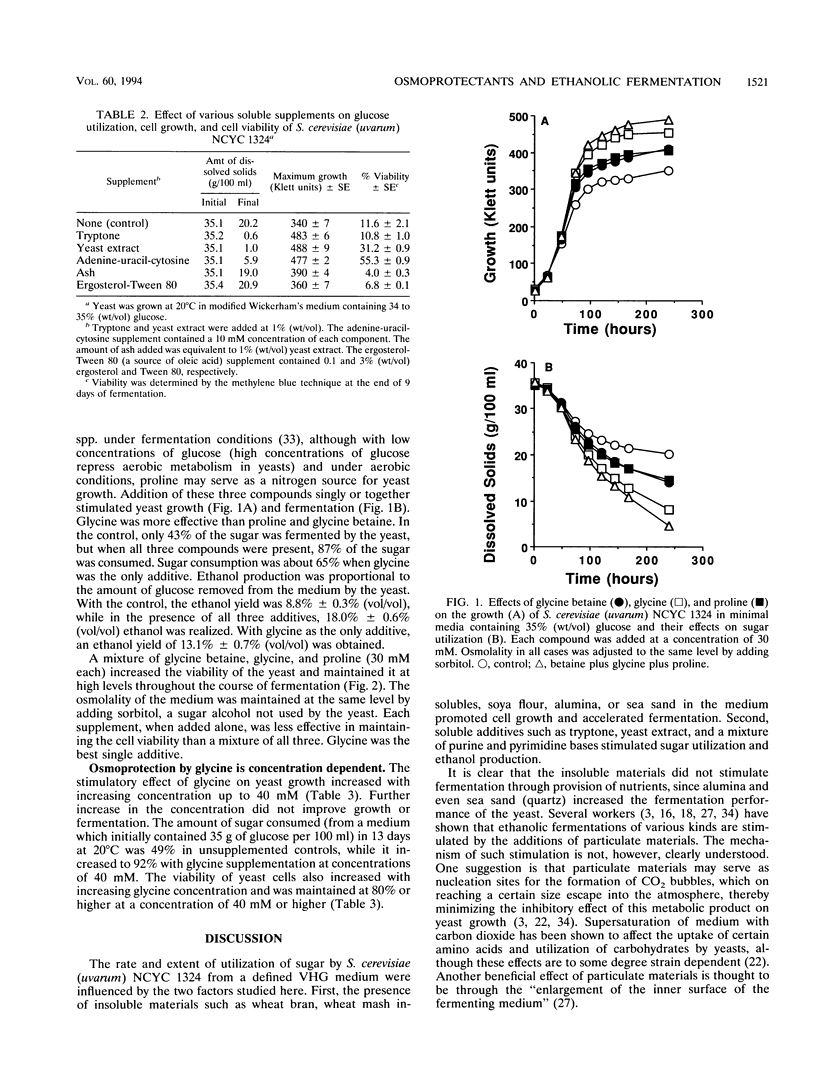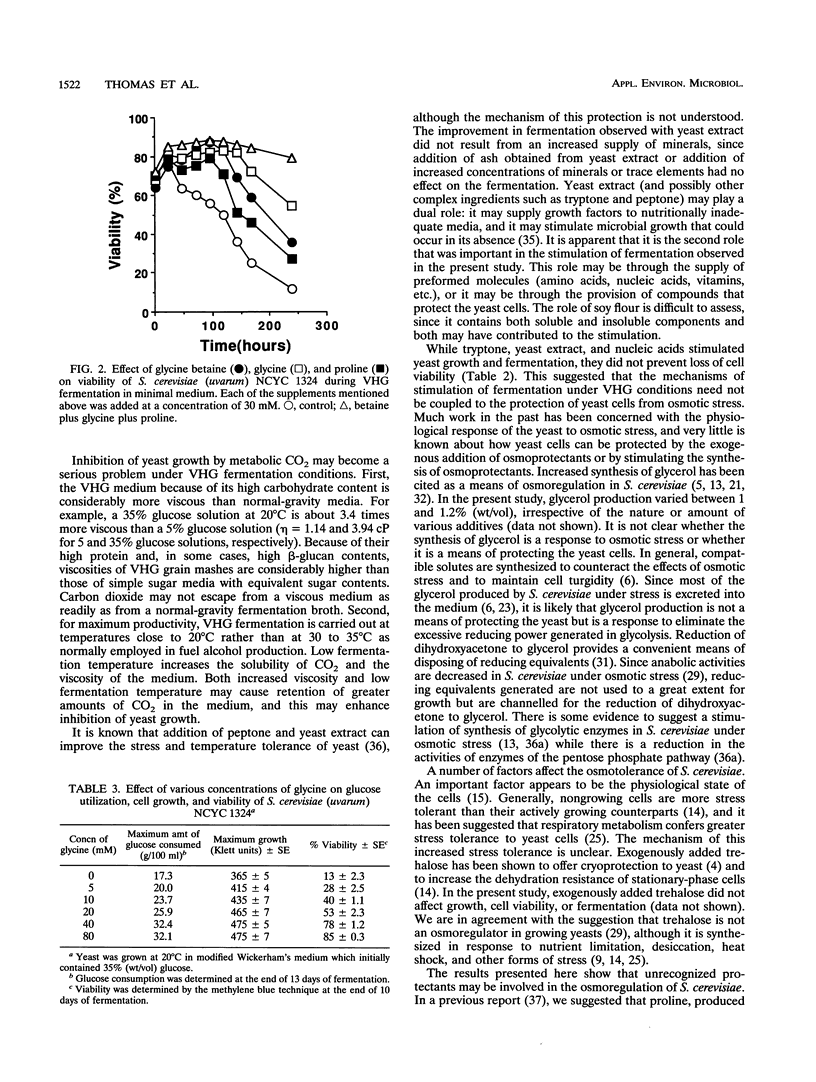Abstract
The effects of osmoprotectants (such as glycine betaine and proline) and particulate materials on the fermentation of very high concentrations of glucose by the brewing strain Saccharomyces cerevisiae (uvarum) NCYC 1324 were studied. The yeast growing at 20 degrees C consumed only 15 g of the sugar per 100 ml from a minimal medium which initially contained 35% (wt/vol) glucose. Supplementing the medium with a mixture of glycine betaine, glycine, and proline increased the amount of sugar fermented to 30.5 g/100 ml. With such supplementation, the viability of the yeast cells was maintained above 80% throughout the fermentation, while it dropped to less than 12% in the unsupplemented controls. Among single additives, glycine was more effective than proline or glycine betaine. On incubating the cultures for 10 days, the viability decreased to only 55% with glycine, while it dropped to 36 and 27%, respectively, with glycine betaine and proline. It is suggested that glycine and proline, known to be poor nitrogen sources for growth, may serve directly or indirectly as osmoprotectants. Nutrients such as tryptone, yeast extract, and a mixture of purine and pyrimidine bases increased the sugar uptake and ethanol production but did not allow the population to maintain the high level of cell viability. While only 43% of the sugar was fermented in unsupplemented medium, the presence of particulate materials such as wheat bran, wheat mash insolubles, alumina, and soy flour increased sugar utilization to 68, 75, 81, and 82%, respectively.
Full text
PDF





Selected References
These references are in PubMed. This may not be the complete list of references from this article.
- Anderson C. B., Witter L. D. Glutamine and proline accumulation by Staphylococcus aureus with reduction in water activity. Appl Environ Microbiol. 1982 Jun;43(6):1501–1503. doi: 10.1128/aem.43.6.1501-1503.1982. [DOI] [PMC free article] [PubMed] [Google Scholar]
- Blomberg A., Adler L. Roles of glycerol and glycerol-3-phosphate dehydrogenase (NAD+) in acquired osmotolerance of Saccharomyces cerevisiae. J Bacteriol. 1989 Feb;171(2):1087–1092. doi: 10.1128/jb.171.2.1087-1092.1989. [DOI] [PMC free article] [PubMed] [Google Scholar]
- Brown A. D. Compatible solutes and extreme water stress in eukaryotic micro-organisms. Adv Microb Physiol. 1978;17:181–242. doi: 10.1016/s0065-2911(08)60058-2. [DOI] [PubMed] [Google Scholar]
- Brown A. D., Simpson J. R. Water relations of sugar-tolerant yeasts: the role of intracellular polyols. J Gen Microbiol. 1972 Oct;72(3):589–591. doi: 10.1099/00221287-72-3-589. [DOI] [PubMed] [Google Scholar]
- Casey G. P., Magnus C. A., Ingledew W. M. High-gravity brewing: effects of nutrition on yeast composition, fermentative ability, and alcohol production. Appl Environ Microbiol. 1984 Sep;48(3):639–646. doi: 10.1128/aem.48.3.639-646.1984. [DOI] [PMC free article] [PubMed] [Google Scholar]
- Csonka L. N., Hanson A. D. Prokaryotic osmoregulation: genetics and physiology. Annu Rev Microbiol. 1991;45:569–606. doi: 10.1146/annurev.mi.45.100191.003033. [DOI] [PubMed] [Google Scholar]
- D'Souza-Ault M. R., Smith L. T., Smith G. M. Roles of N-acetylglutaminylglutamine amide and glycine betaine in adaptation of Pseudomonas aeruginosa to osmotic stress. Appl Environ Microbiol. 1993 Feb;59(2):473–478. doi: 10.1128/aem.59.2.473-478.1993. [DOI] [PMC free article] [PubMed] [Google Scholar]
- Iconomou L., Psarianos C., Kanellaki M., Kalliafas A., Kana K., Koutinas A. A. The promotion of molasse alcoholic fermentation using Saccharomyces cerevisiae in the presence of gamma-alumina. Appl Biochem Biotechnol. 1991 Oct;31(1):83–96. doi: 10.1007/BF02922128. [DOI] [PubMed] [Google Scholar]
- Larsson C., Gustafsson L. Glycerol production in relation to the ATP pool and heat production rate of the yeasts Debaryomyces hansenii and Saccharomyces cerevisiae during salt stress. Arch Microbiol. 1987 May;147(4):358–363. doi: 10.1007/BF00406133. [DOI] [PubMed] [Google Scholar]
- Le Rudulier D., Strom A. R., Dandekar A. M., Smith L. T., Valentine R. C. Molecular biology of osmoregulation. Science. 1984 Jun 8;224(4653):1064–1068. doi: 10.1126/science.224.4653.1064. [DOI] [PubMed] [Google Scholar]
- Lewis J. G., Learmonth R. P., Watson K. Role of growth phase and ethanol in freeze-thaw stress resistance of Saccharomyces cerevisiae. Appl Environ Microbiol. 1993 Apr;59(4):1065–1071. doi: 10.1128/aem.59.4.1065-1071.1993. [DOI] [PMC free article] [PubMed] [Google Scholar]
- Makemson J. C., Hastings J. W. Glutamate functions in osmoregulation in a marine bacterium. Appl Environ Microbiol. 1979 Jul;38(1):178–180. doi: 10.1128/aem.38.1.178-180.1979. [DOI] [PMC free article] [PubMed] [Google Scholar]
- Olz R., Larsson K., Adler L., Gustafsson L. Energy flux and osmoregulation of Saccharomyces cerevisiae grown in chemostats under NaCl stress. J Bacteriol. 1993 Apr;175(8):2205–2213. doi: 10.1128/jb.175.8.2205-2213.1993. [DOI] [PMC free article] [PubMed] [Google Scholar]
- Reed R. H., Chudek J. A., Foster R., Gadd G. M. Osmotic significance of glycerol accumulation in exponentially growing yeasts. Appl Environ Microbiol. 1987 Sep;53(9):2119–2123. doi: 10.1128/aem.53.9.2119-2123.1987. [DOI] [PMC free article] [PubMed] [Google Scholar]
- Smith J. S., Hillier A. J., Lees G. J. The nature of the stimulation of the growth of Streptococcus lactis by yeast extract. J Dairy Res. 1975 Feb;42(1):123–138. doi: 10.1017/s0022029900015156. [DOI] [PubMed] [Google Scholar]
- Thomas K. C., Ingledew W. M. Fuel alcohol production: effects of free amino nitrogen on fermentation of very-high-gravity wheat mashes. Appl Environ Microbiol. 1990 Jul;56(7):2046–2050. doi: 10.1128/aem.56.7.2046-2050.1990. [DOI] [PMC free article] [PubMed] [Google Scholar]


